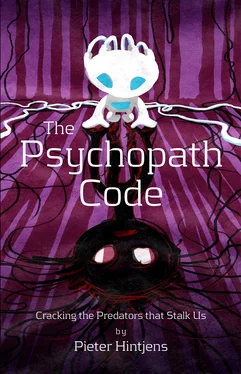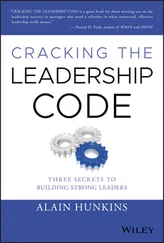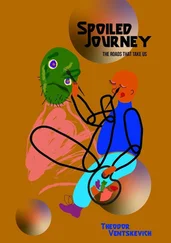We see the clear difference between killing for survival, and killing for pleasure. The I-Rex has the talents of a predator, yet exists outside the natural balance. It never had an environment in which to learn its place. When the velociraptors and T-Rex bring down the dragon, we cheer.
This is the theme of the popular US TV series Dexter. The protagonist is a predator who hunts serial killers. Whether Dexter is a serial killer or even a psychopath is debatable. He is charming, stealthy, and lacks all empathy. Yet he protects innocents from men who have put themselves outside society. He does not manipulate people. He has a job that involves real work, not conning people.
We see what appear to be serial killers in nature. The British built their first East African railways late in the nineteenth century. A pair of male lions in Tsavo [60] https://en.wikipedia.org/wiki/Tsavo_Man-Eaters
learned to eat humans. They started attacking railway workers. By the time Lt. Col. John Henry Patterson shot the two lions, they had eaten 35 people.
Lions evolved to eat large African wild animals. Attacking humans is a losing strategy. In normal times, male lions live with a pride of females. The pride hunts zebras, wildebeest, gnu, buffalo, gazelle, and so on. It is the sister lionesses in the pride that organize the hunts. Most male lion cubs do not survive to reproduce. So these two lions were outside the system, so to speak. It is possible they had learned to scavenge corpses. When railway workers moved into their territory, the humans became irresistible targets.
In 2005, the FBI published a readable and detailed report called "Serial Murder" [61] https://www.fbi.gov/stats-services/publications/serial-murder
. It is worth reading from start to end. Some key points: serial killers span all ethnic groups. They are territorial. They kill for a variety of motives: sexual, thrill, financial gain, anger, and attention. They may pause or stop killing when they have other priorities. They improve their skills and range over time. When they get caught, it is not on purpose. "It is not that serial killers want to get caught. They feel that they can’t get caught," says the report.
The report looks at the origins of serial killers. It argues for a mix of biology and environment. Serial killers often come from abusive homes. Young, they are often lonely or isolated in violent environments. In 70% of cases they suffer injuries or traumas to the head when young. The report says:
There are documented cases of people who suffered severe head injuries and ultimately become violent, even when there was no prior history of violence.
The FBI report is pretty clear:
As a group, serial killers suffer from a variety of personality disorders, including psychopathy, anti-social personality, and others. Most, however, are not adjudicated as insane under the law.
What about the different diagnoses given to serial killers? I’ve argued that borderline, histrionic, and narcissistic personality disorders are masks of psychopathy. The forensic psychologist may well see these masks and take them as real.
Psychopaths kill rarely, and only when necessary. Serial killers butcher people for sexual gratification or sport. That seems irrational and self-destructive. Yet the serial killer feels all the benefits, and none of the costs. They do not recognize their victims as living beings. They are confident they will not get caught. That is pure, selfish pragmatism.
Serial killers appear to be psychopaths who have broken something. Not their empathy. Rather, their restraint and calculation of consequences.
The case of Charles Whitman [62] https://en.wikipedia.org/wiki/Charles_Whitman
gives us a strong hint. Whitman’s father appears to have been a psychopath. Whitman himself showed some of the traits. Charm and small-scale criminality. On 1 August 1966, he shot 16 people, after complaining about "tremendous" headaches. A later autopsy showed a tumor pressing on his amygdala.
Like the I-Rex and the Tsavo lions, psychopathic killers live outside the system. I’d guess most are caught rapidly. That is, if a hundred psychopaths suffer the specific damage to their amygdala that turns them into killers, then ninety-nine get caught and imprisoned after one or two murders. As such they never count as "serial killers." The careers of those we know about is likely to be survivorship bias [63] https://en.wikipedia.org/wiki/Survivorship_bias
.
Serial killers are so scary and fascinating because they epitomize the psychopath’s predator traits. Every time we read about a serial killer we think of all our near escapes. You almost never see the psychopath’s predatory nature naked, in the daylight. Mallory hides so well. Serial killers show us Mallory naked and exposed, in broad daylight. It is a scary and yet compelling sight.
Psychopathic households live in violence, emotional and physical. Few of the victims report even physical violence [64] https://en.wikipedia.org/wiki/Domestic_violence#Under-reporting
to the police. Let alone neglect and emotional violence, which can be hard to explain and prove. About one third of women and men alike pass through an abusive relationship. About 40% of murders of women are at the hands of their partners [65] https://en.wikipedia.org/wiki/Domestic_violence#Forms
, compared to 6% for men.
I’m not claiming that violence is Mallory’s monopoly. Most violent male deaths are at the hands of other men. And most often in disputes over women, territory, or status. Male-on-male violence does not shock us. We have institutionalized it as war. We glorify it in our culture.
What I am claiming is that the abusive relationship is a psychopath’s digestive system. How it starts, how it flows, and how it ends are a evolved mechanism. It is how Mallory consumes Alice and Bob. It can be that in some cultures, abusive relationships are the norm. I’d consider these cultures to be psychopathic, like a national cult.
If you know someone who is in an abusive relationship, it is likely one of the two is a psychopath. You must take real care before making a conclusion. Psychopaths lie. They will often claim to be the victim. They will often look exactly as you’d expect a victim to look. Most often there is no visible violence. As I explained, the real victims do not like to talk about their experiences.
So the violence tends to resurface in a different form: self-harm.
A million people a year take their own lives [66] http://medicalxpress.com/news/2012-09-million-people-commit-suicide-year.html
, reported the WHO in 2012. For every death, there are 20 attempts. The WHO says 5% of people will try at least once to take their own lives. I think they under-counted. 20 million x 70 (global life expectancy) makes 1.4 billion, or 1/5th of the world population in 2012.
Attempted suicide is a cry for help from someone who has no other voice. For every suicidal person, how many live in long term depression? Five, ten, fifty? The WHO estimates 350 million people live in depression globally. It says, "depression is the leading cause of disability worldwide." As men tend to not ask for help [67] http://www.ncbi.nlm.nih.gov/pubmed/12584064
, the real figure may be much higher.
I’ve explained how Mallory feeds. It is usually a slow business, yet it is violent. It often drives Alice and Bob to long term depression, PTSD, or suicide. While Mallory is not a serial killer, he is a serial abuser. His selfish use of others can result in death.
Mallory deserves his dark caricature. It’s not just that he causes such massive amounts of suffering and death. It’s that he does this pragmatically, to control his victims, and to stop them talking.
Читать дальше












